- Quick Read
- Deep Read ( 6 Min. )

Why is Christian Science in our name?
Our name is about honesty. The Monitor is owned by The Christian Science Church, and we’ve always been transparent about that.
The Church publishes the Monitor because it sees good journalism as vital to progress in the world. Since 1908, we’ve aimed “to injure no man, but to bless all mankind,” as our founder, Mary Baker Eddy, put it.
Here, you’ll find award-winning journalism not driven by commercial influences – a news organization that takes seriously its mission to uplift the world by seeking solutions and finding reasons for credible hope.
Explore values journalism About usIn Today’s Issue
Monitor Daily Podcast
- Follow us:
- Apple Podcasts
- Spotify
- RSS Feed
- Download
TODAY’S INTRO
Buddy Guy and joy in the blues
On a recent frigid evening in Chicago, a spot of warmth was emanating from a blues club off South Wabash Avenue. Every January, iconic bluesman Buddy Guy plays at his home club, Legends. This year, he’s starting his farewell tour.
Mr. Guy is the last of a long line of blues guitarists – some call him the greatest – who left hardscrabble Southern childhoods for a new life in Chicago. Now 86, he feels like he’s charged with keeping the blues alive. He took the stage last month in a wide-brim hat, coral suit, black-and-white sneakers, and a Fender Stratocaster slung over his shoulder. His club hummed with vibrant joy.
Chicago has had its share of troubles, from rising crime to racial tensions. But it is also the crossroads of historic exchange between Black and white cultures, the blues bending and blending human emotion into a steady 4/4 rhythm, a building block heard in the Inventions of Bach and even Madonna’s pop hits.
Sadness might be the place you start from when playing the blues, but that’s not where you end up. “The blues chase the blues away,” Mr. Guy regularly reminds audiences.
The blues is about facing truth and still expressing joy. You could see it in his smile as he stepped off the stage and strode through the crowd, still strumming his Strat, until he reached the street outside – the blues amplified into Chicago’s cold night air. He’s won eight Grammys, and a host of other honors. His 2022 album “The Blues Don’t Lie” has earned another Grammy nomination. The winners will be announced Sunday, Feb. 5.
Whether Mr. Guy wins again doesn’t really matter. His legacy is set in a tradition that’s been crafted over time. The blues tells an important story about us – and it’s a vital, life-giving part of American history.
Share this article
Link copied.

Help fund Monitor journalism for $11/ month
Already a subscriber? Login

Monitor journalism changes lives because we open that too-small box that most people think they live in. We believe news can and should expand a sense of identity and possibility beyond narrow conventional expectations.
Our work isn't possible without your support.
West Bank violence: Palestinians seeking safety see fewer options
Feeling abandoned amid the West Bank’s latest explosive cycle, how do Palestinian civilians protect themselves? Even as some embrace mutual aid, others resort to violence.
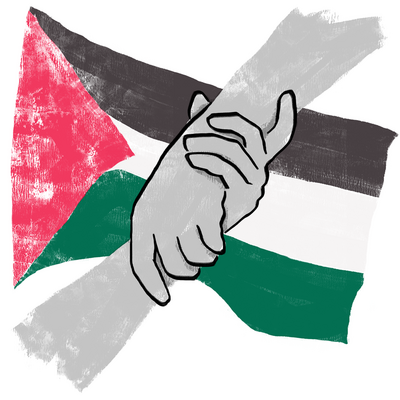
-
By Fatima AbdulKarim Special contributor
-
Taylor Luck Special correspondent
On a previously scheduled trip to the region, U.S. Secretary of State Antony Blinken was forced this week to address a sudden spike in Israeli-Palestinian violence that made January the deadliest month in the West Bank in years. He called on both sides to de-escalate, and in a meeting Tuesday with Palestinian Authority President Mahmoud Abbas in Ramallah, he expressed “our condolences and sorrow for the innocent Palestinian civilians who’ve lost their lives in escalating violence over the last year.”
Yet that recognition of Palestinian insecurity by America’s top diplomat did little to paper over the sense among Palestinian civilians that they are under attack from both the Israeli military and settlers, and have no one but themselves to rely on for their safety.
Around the West Bank, some have responded to the violence by embracing mutual aid, from volunteer paramedics to firefighters. Yet others have formed local militias, while some young men have been spurred to carry out unpredictable “lone wolf” attacks targeting Israeli civilians.
“It’s like our lives don’t matter at all,” says a recent university graduate in Ramallah. “Our youth are either being radicalized or completely detached from reality. ... They are all left to face this alone. We all are.”
West Bank violence: Palestinians seeking safety see fewer options

Community watches, neighbors as first responders, the creation of local militias: After a spike in Israeli-Palestinian violence and the deadliest month in the West Bank in years, Palestinians who feel vulnerable and abandoned say they have dwindling options to protect lives and property increasingly under threat.
Repeated deadly Israeli military raids in West Bank towns and camps and a surge in settler attacks under a new far-right Israeli government, some of whose members appear eager to fan the flames, have been met with an uptick in Palestinian so-called lone wolf attacks.
Familiar calls by the international community for restraint and calm as a response to this cycle of violence are doing little to fill a void of security for Palestinian civilians who feel exposed and leaderless. As West Bank residents turn inward to protect one another, that void is being filled by brave neighbors and would-be militants, amid calls by some for a violent response.
A raid last week against a militia group in the West Bank town of Jenin, in which the Israeli military killed 10 people – militants and civilians – raised the number of Palestinians killed in the violence in January to 30.
One day later, a Palestinian gunman killed seven Israeli civilians outside an East Jerusalem synagogue after Sabbath prayers in a lone wolf attack, the deadliest terrorist attack on Israelis in years.
U.S. Secretary of State Antony Blinken, on a previously scheduled trip to the region, met this week with Israeli Prime Minister Benjamin Netanyahu and Palestinian Authority President Mahmoud Abbas and called for “steps to de-escalate, to stop the violence, to reduce tensions,” and “to create the foundation for more positive actions.”
In his meeting with the isolated, unpopular, and increasingly autocratic Mr. Abbas Tuesday, Secretary Blinken expressed “our condolences and sorrow for the innocent Palestinian civilians who’ve lost their lives in escalating violence over the last year.”
“Palestinians and Israelis alike are experiencing growing insecurity, growing fear in their homes, in their communities, in their places of worship,” he said.
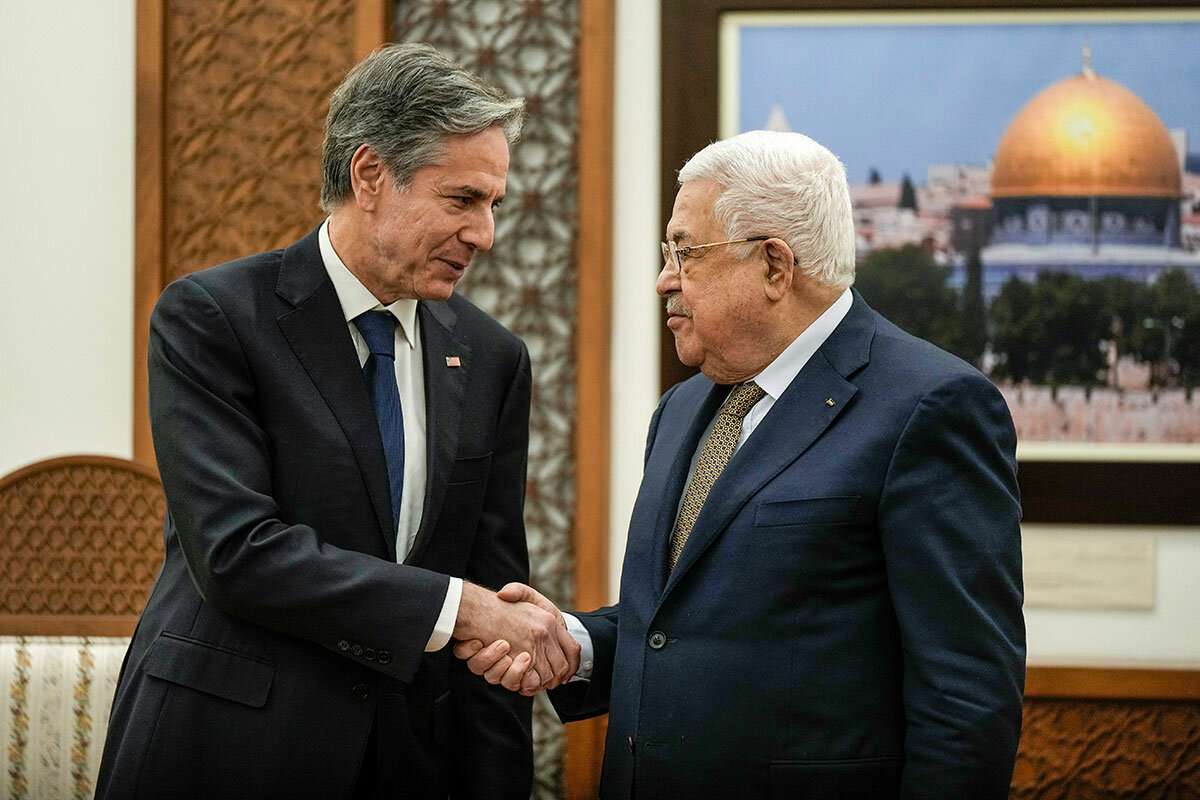
Yet the visit to Ramallah by America’s top diplomat and his recognition of Palestinian insecurity did little to paper over the sense among Palestinians that they are under attack and have nowhere to turn.
“With this insecurity, we are losing trust in each other and the leaders who are supposed to protect us,” says Maha Buheis, a fresh university graduate in Ramallah. “It’s like our lives don’t matter at all.”
Neighbors as first responders
Amid that feeling of abandonment, everyday Palestinians are stepping up as sentries, first responders, even firefighters.
Following the synagogue attack, the Palestinian Authority recorded more than 20 settler and far-right Israeli revenge attacks on Palestinian civilians in the West Bank within 24 hours; Israel’s own monitoring counted more than 35 such attacks against Palestinians – ranging from stone-throwing to arson.
When far-right Israeli settlers set fire to a home and vehicle in the West Bank village of Turmus Aya Saturday, it was neighbors and relatives who put out the blaze.
During the raid in Jenin last week, neighbors stepped up when Kifaya Obeid’s mother, Majida, was hit by a bullet while in her room and the ambulance could not enter the camp.
Paramedics appeared at their door within minutes and gave her mother first aid, put her on a stretcher, and carried her through the alleyways amid gunfire to an ambulance on the outskirts of the camp. They were familiar faces.
“I knew those first responders!” Ms. Obeid says. “Those were my neighbors.”
Her mother died from her wounds at the Jenin hospital while her daughters were pinned down at home by Israeli gunfire.
According to a Palestinian security liaison, ambulances are no longer protected under evolving Israeli military rules of engagement. With more ambulances being hit during increasingly deadly firefights between Israel and militants, paramedic Hatem and his colleagues devised the community first-responders network to get those wounded out of the Jenin refugee camp, a maze of narrow alleyways that is home to 11,000 residents and the Jenin Battalion militia.
“Only people born in the camp can find the ways out of here,” Hatem says as he and colleagues – the volunteers had barely been trained for a week – cleaned blood from ambulances hours after the raid.
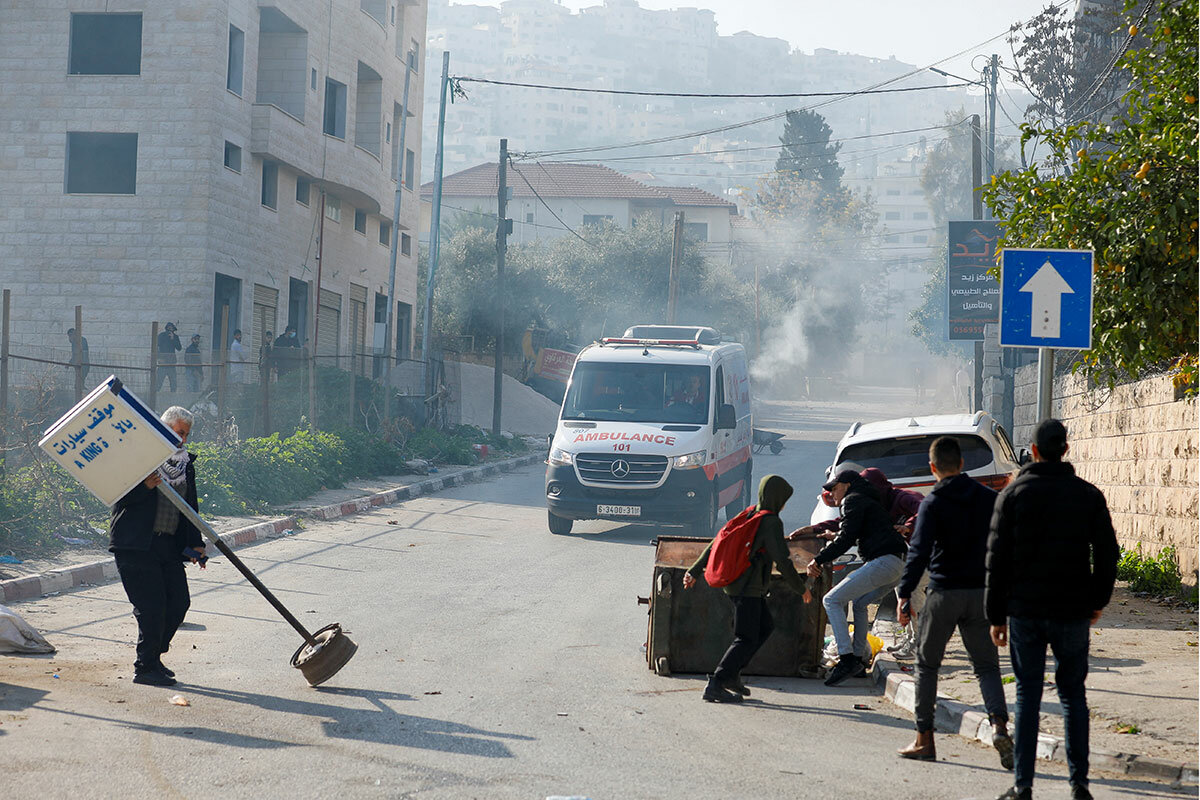
“All in this together”
Another Jenin civilian casualty, schoolteacher Jawad Bawaqneh, was shot and killed by the Israeli military while attempting to assist another man shot at his doorstep, residents say. The ambulance attempting to reach Mr. Bawaqneh’s home was shot at twice and was forced to turn back.
Then a man in a fluorescent vest appeared, recalls Mr. Bawaqneh’s daughter, Alaa Bawaqneh.
“I didn’t see where he came from, but I knew him; he was our neighbor, a lawyer,” she says. The volunteer paramedic tended to her father’s wounds and then moved him to a private car that drove him to hospital, where he died of his wounds.
“Our camp does this together because we are all in this together,” says Hatem, who did not wish to use his full name. “No one is protected when the Israeli military comes.”
Outside Nablus, in Huwara, near the Yitzhar settlement that is home to groups advocating violence against Palestinians, residents have created their own community watch to deal with increasingly frequent settler attacks.
“Hours can pass before the Israeli army intervenes to stop the attacks, and when we defend ourselves, the army only attacks our youths,” says Wajih Huwari, a Huwara municipal council member. “We decided we had to unite.”
Residents and business owners in Huwara and nearby towns formed a hotline on the communications app Telegram to verify and send alerts on the location of settlers. They created the hotline after settlers attempted to set fire to a house in Huwara last year, and fast-thinking neighbors evacuated an older couple and extinguished the fire.
“We realized we needed to make sure that someone was always awake and alert to report,” says Yaqoub Raed, a community watch member. “We only have each other to defend ourselves; media outlets, diplomats, and officials do nothing here in Huwara. It is only us with our backs to the wind.”
While the violence has inspired some young Palestinians to form militias to protect their communities and attack Israel – like the Lions’ Den in Nablus and the Jenin Battalion – it has also begun to spur other young men to carry out unpredictable lone wolf attacks targeting civilians.
“There is no in-between”
It comes amid what Palestinians describe as a void of leadership and hope.
Even the Islamist militant group Hamas that governs Gaza, which has offered no long-term peaceful vision, is currently showing no willingness to confront Israel as it tries to rebuild its weapon caches following the 2021 Gaza war.
“Our youth are either being radicalized or completely detached from reality. There is no in-between, and who can blame them,” says Ms. Buheis, the Ramallah university student. “They are all left to face this alone. We all are.”
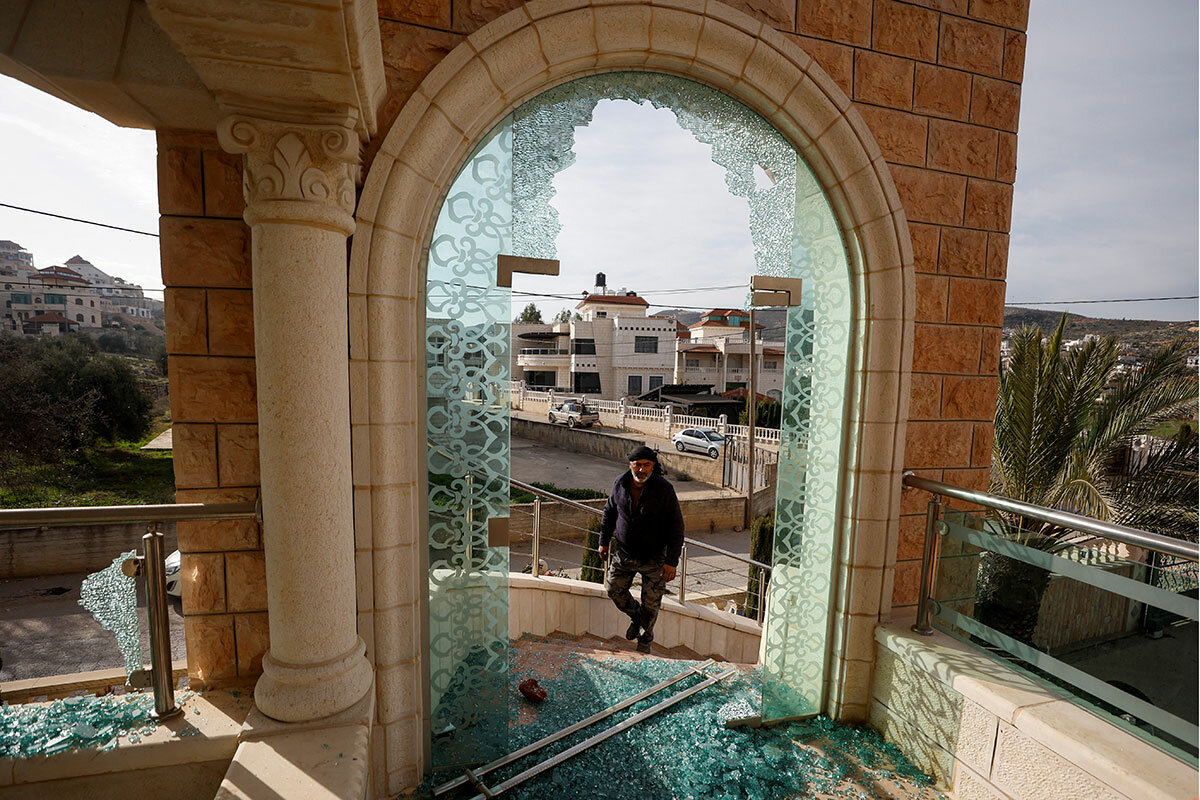
Symbols of the lack of hope and the cycle of intercommunal violence are many.
According to the Israeli newspaper Haaretz, the grandfather of the shooter outside the synagogue was killed leaving a mosque by an Israeli extremist in 1998, and the gunman’s 17-year-old cousin was killed in an Israeli military raid last week outside Jerusalem.
News of the synagogue attack prompted celebrations among some Palestinians. Yet there are also many who oppose the killing of civilians and fear radicalization’s impact on their society.
Secretary Blinken acknowledged this despair.
“What we’re seeing now from Palestinians is a shrinking horizon of hope, not an expanding one; and that, too, we believe needs to change,” he said from Ramallah Tuesday.
“They are leaving us to die”
Young Palestinians mocked American and international calls for concern.
“If we wait for a response from the international community, it means we wait for the Israelis to kill our mothers. Then what?” says Hakeem, who recently joined a watch group in his home village of Qusra outside Nablus. “The young people carrying out attacks are sending a message to the ‘gravely concerned’ international community: They are leaving us to die.”
Despite the potential to ignite wider communal violence, he says lone wolf attacks and violence are the Palestinians’ “only tool” to force Israel to rethink its policies and the occupation of Palestinian lands.
Majd Khoury, an NGO worker in Ramallah, shares the concern of many Palestinians that a U.S. policy of economic aid and attempts to suppress violence without a permanent political solution is “unsustainable.”
“We are all afraid of an outbreak of violence,” he says, “but can we suppress it if daily killings, settler attacks, and annexation continue?”

New Hampshire says ‘not so fast’ to new primary calendar
As Democrats vote this week on a plan for South Carolina to lead the 2024 primaries, New Hampshire says its “first-in-the-nation” status should be preserved – signaling a messy fight ahead.
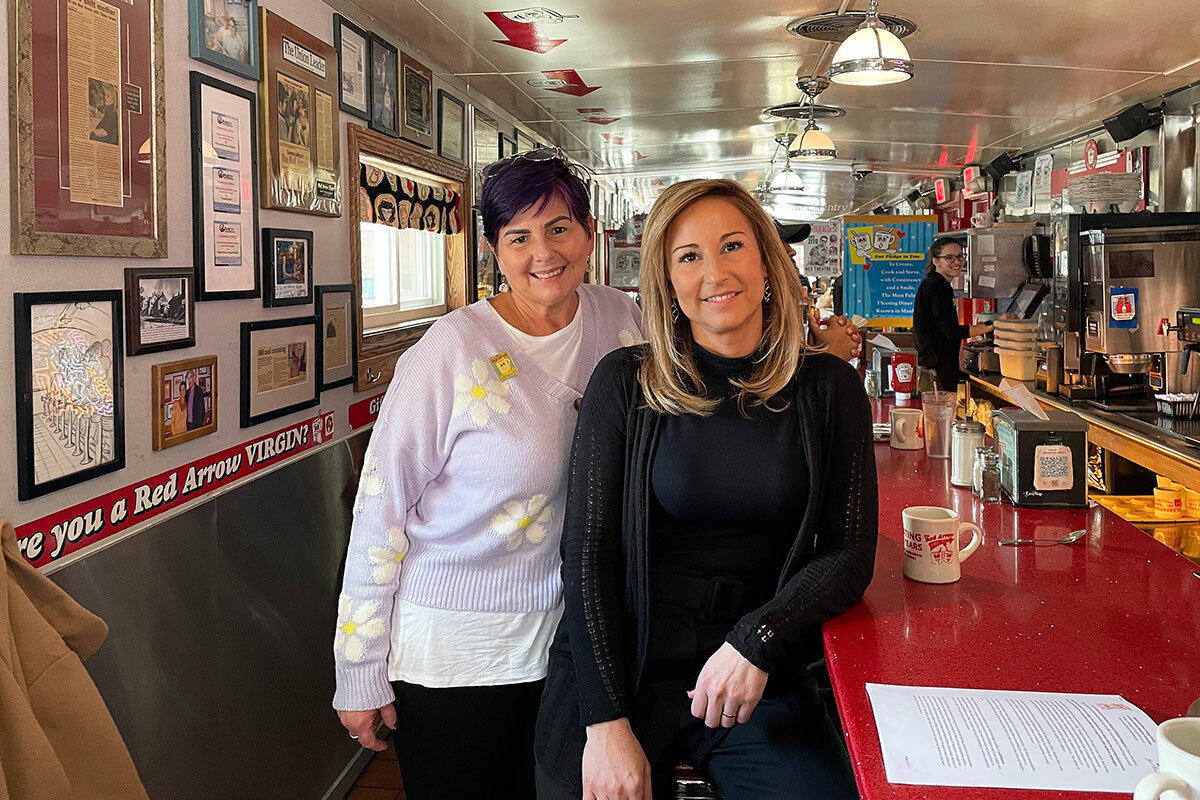
- Quick Read
- Deep Read ( 7 Min. )
For more than a century, New Hampshire has relished its role shaping presidential history with its first-in-the-nation primary. Voters here enthusiastically embrace the flood of politicos who descend on their state every four years – hosting candidates in their living rooms and casting ballots at one of the highest rates in the country.
But that favored status is now facing an existential threat. Following a recommendation from President Joe Biden, the Democratic National Committee is poised to approve a new primary schedule that would put South Carolina first instead. Advocates say the change would give voters of color a greater say in the nomination process.
New Hampshire is not taking this news well. Granite State voters say their primary is democracy at its best – where candidates are well vetted, and those with the biggest campaign coffers don’t always win. More broadly, many here say Democrats may regret demoting one of the few remaining swing states in the Northeast.
“It’s an important part of our tradition and culture and we take it very, very seriously. ... We believe we are making a real contribution not only to the process, but to the country,” says former Democratic Gov. John Lynch.
New Hampshire says ‘not so fast’ to new primary calendar
Open the door to the Red Arrow Diner too forcefully, and it will smack right into Ted Cruz, Rudy Giuliani, both Bill and Hillary Clinton, and Barack Obama.
Framed photographs of onetime presidential candidates line the New Hampshire diner’s entryway. Many of the candidates drape their arms around Carol Lawrence, the Red Arrow’s owner of 35 years. In fact, the entire place is a time capsule of U.S. politics, with metal nameplates marking various stools where candidates once sat. Hanging behind the counter, a license plate proudly reads “1st in NATION PRIMARY.”
For more than a century, New Hampshire has relished its unique role shaping presidential history, with its primary bestowing a crucial shot of momentum or a harsh dose of reality on White House hopefuls. Voters here enthusiastically embrace the flood of politicos who descend on their small state every four years – hosting candidates in their living rooms, filling town hall auditoriums, and casting ballots at one of the highest rates in the country.
But that favored status is now facing an existential threat. Following a recommendation from President Joe Biden, the Democratic National Committee is poised to approve a new primary schedule that would put South Carolina first instead. Advocates say the change would give voters of color a greater say in the nomination process. The DNC is scheduled to vote on it this weekend at its winter meeting in Philadelphia.
New Hampshire is not taking this news well. Granite State voters say their primary has always been an example of democracy at its best – where candidates are vetted by a well-informed electorate, and those with the biggest campaign coffers don’t always win. More broadly, a scheduling skirmish that may seem like intraparty politics could have much bigger implications. Many here say Democrats may regret demoting New Hampshire – one of the few remaining swing states in the Northeast – when it comes time for the general election.
“It’s an important part of our tradition and culture and we take it very, very seriously. ... We believe we are making a real contribution not only to the process, but to the country,” says John Lynch, who served as the Democratic governor of New Hampshire from 2005 to 2013 and was the lead author of an opposition letter recently sent to President Biden from almost two dozen state Democratic operatives.
“This misguided decision is going to put at risk not only our four Electoral College votes but also the presidency,” he adds. “Maybe people don’t remember that if Al Gore had won New Hampshire, he would have been president.”

Gearing up for a messy fight
Of course, New Hampshire hasn’t really been first for a while. For decades, the presidential nominating process has been kicked off by the Iowa caucuses, followed shortly thereafter by New Hampshire’s primary. New Hampshirites have been fine with this arrangement because, technically speaking, theirs was still the first “primary.” But over the years, activists have increasingly argued that the older, whiter populations of both Iowa and New Hampshire didn’t accurately reflect the makeup of the Democratic Party. Past efforts to change the primary calendar led to other states being strategically moved earlier or later – for the past three presidential cycles, Nevada and South Carolina have followed closely on New Hampshire’s heels – but never dislodged Iowa or New Hampshire.
Embarrassing mishaps in 2020 with Iowa’s caucuses – long criticized as arcane and confusing – appear to have been a tipping point. Iowa Democrats do not seem to be mounting a serious effort to oppose the new calendar, which would give South Carolina the first primary, followed by New Hampshire and Nevada three days later, and then Georgia and Michigan.
New Hampshire, on the other hand, is gearing up for what could be a messy fight.
One looming problem with the DNC’s new plan is that Republicans are not going along with it. The GOP is leaving New Hampshire at the top of its party’s nominating calendar in 2024. At a campaign stop at the New Hampshire Republican Party’s meeting in Salem on Saturday, former President Donald Trump earned some of his loudest applause when he voiced his commitment to New Hampshire’s “incredible tradition” of hosting the nation’s first primary.
GOP Gov. Chris Sununu has made similar statements, confirming that he, along with New Hampshire’s legislature, has no intention of overturning a 1975 state law that mandates New Hampshire hold the first primary in the country.

The DNC has told New Hampshire that its second-place position in the new calendar is contingent on repealing this law, as well as implementing more early voting opportunities. As further leverage, the DNC is threatening to withhold delegates from candidates who campaign in any states that hold their primaries out of order.
Since Republicans control New Hampshire’s legislature and governorship, local Democratic officials say they’ve been placed in a no-win position.
“They want to punish the New Hampshire Democrats for something we have no control over,” says Raymond Buckley, who has served as chair of the New Hampshire Democratic Party since 2007.
Some liken the current situation to a game of chicken, with both New Hampshire and the DNC hoping the other will blink first. For now, both sides appear steadfast.
“Regardless of what the DNC comes out with, we will go first,” says Mr. Lynch.
“The DNC has done this before and it didn’t cave,” counters Elaine Kamarck, a member of the DNC’s Rules and Bylaws Committee, adding that the DNC “showed great backbone” in 2008, when it removed Michigan and Florida from the list of early primary states.
Mr. Buckley agrees with the chicken analogy, to a point. With the state law as it is, he says he doesn’t have the power to blink even if he wanted to. “You can’t play chicken when you’re blindfolded,” he says, throwing his hands in the air in frustration.

“Biden owes New Hampshire absolutely nothing”
Like the Red Arrow Diner, Mr. Buckley’s office at the party’s headquarters in Concord is a shrine to decades of presidential contenders. An entire bookshelf is dedicated to former President Jimmy Carter, whose New Hampshire campaign not only sparked a young Mr. Buckley’s interest in politics, but also affirmed what the New Hampshire primary can do for underfunded hopefuls with little name recognition.
After Mr. Carter, a peanut farmer and former governor of Georgia, announced his candidacy in 1976, a home state newspaper ran the headline ”Jimmy Who Is Running For What!?” But after logging hundreds of hours with voters in Iowa and New Hampshire, Mr. Carter won both contests, propelling him into the national spotlight and ultimately the White House.
Yet virtually ever since, party officials have been fighting over the primary schedule. The call to change it has only grown louder as the Democratic Party has become increasingly reliant on nonwhite voters to win elections. New Hampshire is one of the least diverse states in the country at more than 90% white, unlike South Carolina, where more than one-quarter of voters are Black.
“Too often over the past 50 years, candidates have dropped out or had their candidacies marginalized by the press and pundits because of poor performances in small states early in the process before voters of color cast a vote,” wrote Mr. Biden in his letter to the DNC proposing the change.
Mr. Buckley says the DNC addressed these demographic concerns a few years ago when it moved South Carolina and Nevada into earlier voting spots. That Mr. Biden’s own win in South Carolina was powerful enough to propel him to his party’s nomination after a fifth-place finish in New Hampshire is evidence of South Carolina’s power even in the current calendar.
Indeed, many believe Mr. Biden’s poor performances in New Hampshire and Iowa, where he came in fourth, ultimately paved the way for the proposed changes.
“For half a century, the president of the United States has won either Iowa or New Hampshire or both,” says Ms. Kamarck. This year, “because there was no sitting president defending them, it opened the door for all the complications that had been building for decades about these two states.”
“Unlike past incumbents who often owed something to New Hampshire for being the nominee, Joe Biden owes New Hampshire absolutely nothing,” agrees Dante Scala, a political scientist at the University of New Hampshire.
Still, Mr. Biden’s decision to elevate the primary of a state he won while bumping that of a state he lost has rubbed some voters here the wrong way.
“So now presidents can pick any state they like to go first?” says Kathy Dircks, a retired postmaster from Chester, while shopping at The Mall of New Hampshire.
Ms. Kamarck thinks that may turn out to be the case – with the DNC “entering an era where we revisit this every few years.” In the end, she adds, that might make the whole process fairer.
Back at the Red Arrow Diner, Ms. Lawrence, the owner, gestures to the bustling restaurant around her. A menu advertising the Trump Tower Burger – a hamburger topped with fried macaroni and cheese that she says former President Trump enthusiastically devoured – lies on top of a seat dedicated to Democratic Sen. Amy Klobuchar. To Ms. Lawrence, American politics couldn’t get much fairer than this.
“I welcome them all the same.”

Culture as resistance? Haitians defy gangs by embracing theater
Port-au-Prince is overrun by criminal gangs blocking transit and terrorizing the population. And yet, many Haitians are risking their lives to attend the theater, something they see as an act of resistance.
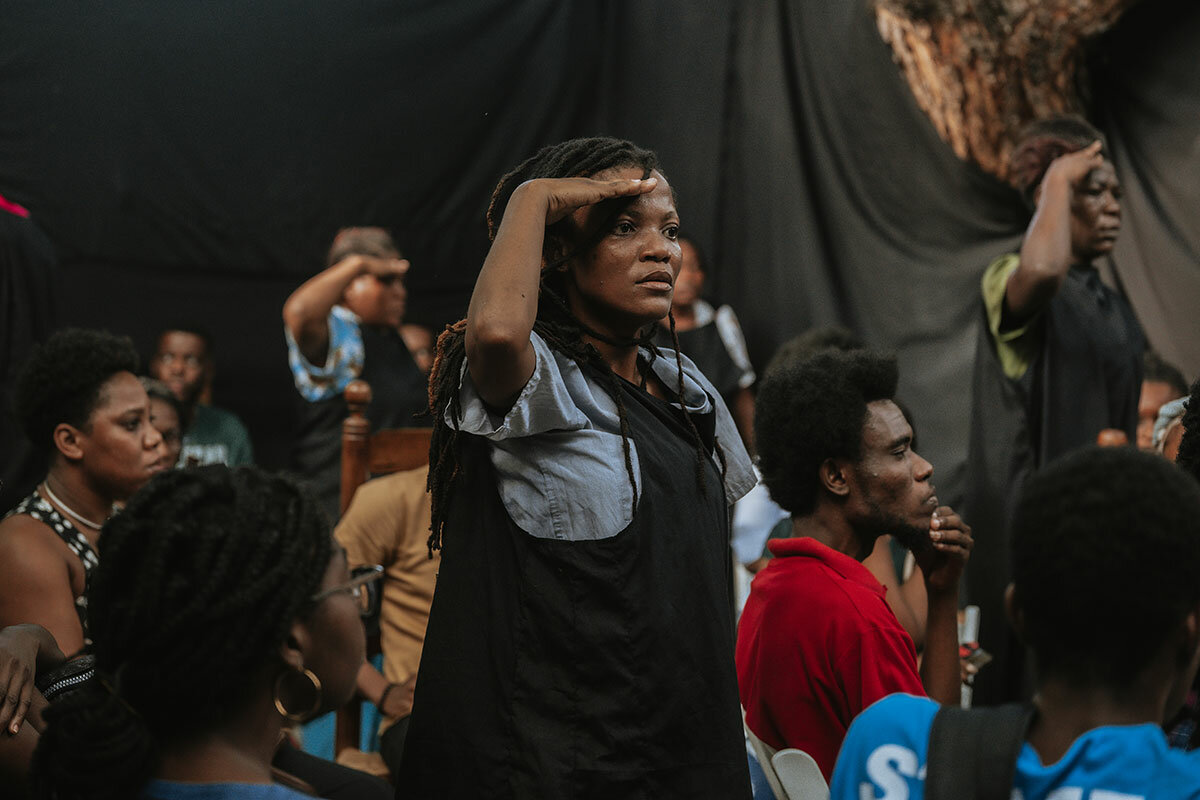
- Quick Read
- Deep Read ( 7 Min. )
-
By Websder Corneille Contributor
Colorful murals of well-known artists and thinkers cover the cement walls at Yanvalou, the unofficial home of Haiti’s theater scene. The bright decor matches the vivacity of the crowd gathered here today to watch a reading of the first play in the annual Quatre Chemins (Four Paths) theater festival.
The fact that there’s a full house was never a given. Haiti’s capital has been overrun by criminal gangs for the past three years, especially since the assassination of President Jovenel Moïse in July 2021. The groups terrorize citizens, carrying out kidnappings, sexual assaults, and armed robberies. Yet for the 60 audience members today, watching live theater was worth the risk of navigating Port-au-Prince’s chaos.
Art, and specifically theater, have a rich history of political resistance in Haiti. Although the unprecedented climate of insecurity here has more to do with a vacuum of leadership than with the overt oppression and censorship that citizens faced under dictatorships in the past, the crowd today is a reminder that theater remains an act of defiance.
“Culture is one of the strongest ways we resist,” says Stephanie Jean, a young NGO worker. “In such a politically and economically fraught context, art is how we remind ourselves and the world that we are alive.”
Culture as resistance? Haitians defy gangs by embracing theater
On a sunny afternoon, some 60 people gather in the small courtyard of Yanvalou Café, the unofficial home of Haiti’s theater scene. It’s the opening of the 19th annual Quatre Chemins (Four Paths) theater festival, but the fact that there’s a full house was never a given.
For the past three years, Port-au-Prince, Haiti’s capital, has been overrun by criminal gangs. They’ve increasingly terrorized citizens, carrying out kidnappings, sexual assaults, and armed robberies, and blocking freedom of movement since the assassination of President Jovenel Moïse in July 2021. Many citizens have fled their homes in recent months, seeking safety elsewhere – in some cases camping out in public parks because their neighborhoods have become so dangerous.
“This city is scary these days,” says Évens Dossous, an educator who came to see the reading of “Port-au-Prince et sa Douce Nuit (Port-au-Prince and Its Sweet Night),” a new play by award-winning Haitian playwright Gaëlle Bien-Aimé. Before leaving home this afternoon, “I asked myself, ‘Is it really worth traveling? Will I be kidnapped?’”
Art, and specifically theater, have a rich history of political resistance in Haiti. Although the unprecedented climate of insecurity has more to do with a vacuum of leadership – there have been no elections since 2016 – than with the overt oppression and censorship that citizens faced under dictatorships in the past, the crowd at Yanvalou today is a reminder that theater remains an act of defiance.
“You know, life can’t just be about insecurity,” says Mr. Dossous.
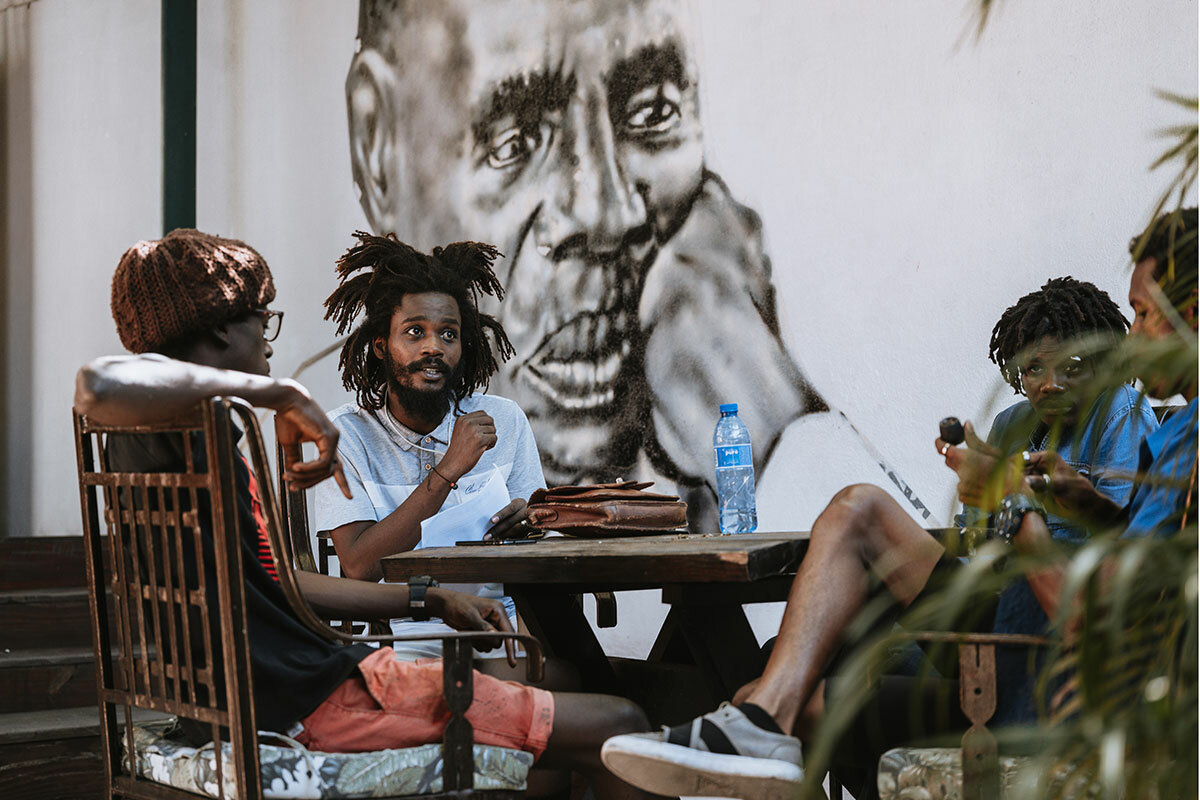
“A living art” amid violence
Colorful murals of well-known artists and thinkers cover the cement walls at Yanvalou, including singer Nina Simone, Haitian dancer Viviane Gauthier, and national anthropologist Jean Price-Mars. The audience at the opening in November makes its way from the courtyard into the restaurant, where chairs are set up facing two lecterns.
The reading focuses on the lives of two young people, madly in love, in a home in Pacot, a wooded, formerly upscale neighborhood in the heart of Port-au-Prince. It underscores many real-life challenges, like the fragile state of the capital and the difficulty of leaving the house to get food, travel, or go to school or work. But it also dives into bigger questions, such as how to love – oneself and others – when a city is collapsing around you.
“Theater helps me ask questions about my life,” says Ms. Bien-Aimé, the playwright, who was the second Haitian in a row to win the prestigious RFI Theatre prize, awarded to emerging Francophone artists. Theater “is a living art,” she says.
Since the assassination of President Moïse, armed gangs have taken control of some 70% of the capital. From blockading a fuel terminal last September that immobilized transportation and industry nationally to controlling key neighborhoods, gangs here have generated disorder and hunger, and heightened the political crisis. Some 20,000 Haitians are facing starvation, according to the United Nations, the vast majority of whom are located in the capital.
The insecurity, which includes using sexual violence as a weapon, has led to widespread displacement. Kidnappings increased by nearly 45% in Port-au-Prince in the second quarter of 2022, according to the National Network for the Defense of Human Rights, a Haitian nongovernmental organization. Many believe the gangs are protected by police, politicians, and business elite.
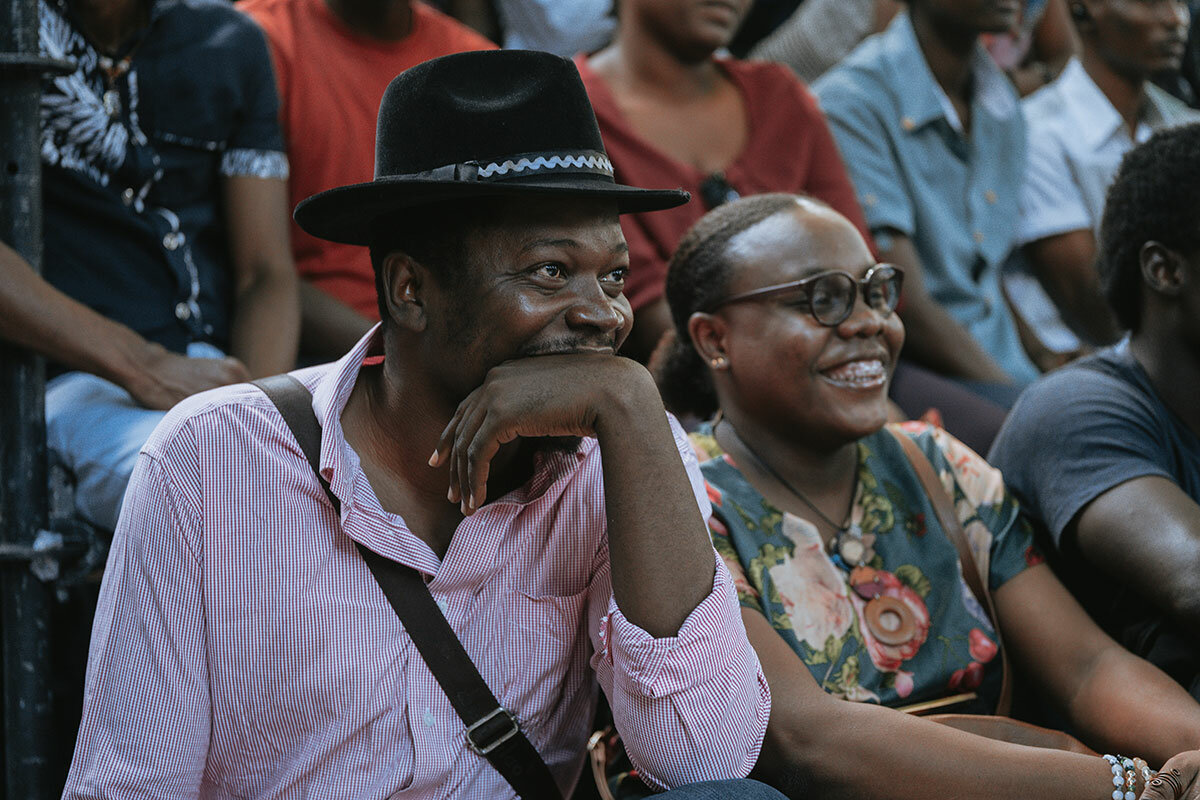
“The state has agreed to retreat so that armed groups can control the society,” says Sabine Lamour, a Haitian sociologist at the State University of Haiti, citing research by Haiti’s leading human rights organization, the National Human Rights Defense Network.
By early October last year, the Haitian government, led by acting President Ariel Henry, officially requested foreign military intervention to tackle security challenges. Despite the chaos here, many reject the idea. Human rights abuses and the introduction of cholera by foreigners working with the U.N.’s stabilization mission in 2010 have left a lasting, negative impression of international meddling. The United States this week charged four men with involvement in Mr. Moïse’s assassination, a reflection of Haiti’s troubled justice system.
Micaëlle Charles, the actor reading the lead role of Zily in today’s play, says a lot has changed in Haitian theater over the past three years. She and the entire team putting on today’s show take security precautions she never considered before, such as sleeping over at the rehearsal space. “This helps me to hold on, despite the problems in the country or any other problems life might throw my way,” she says of her passion for the craft.
“It is unfortunate that artists and cultural organizers have to think about security this much,” says Éliezer Guérismé, artistic director of En Lisant, another performing arts festival. Over the past few years, festivals have started functioning under new, self-imposed rules, such as only holding events during the day, so that spectators can return home while the sun is still up. “This means we can’t do [stage] lighting, but we gain in security, and this allows our public to trust us more,” says Mr. Guérismé.

Culture as resistance?
Using theater for social or political commentary isn’t unique to Haiti, but it has a long tradition here. Theater is “a weapon of mass awareness that gives the spectator the means to free themselves,” wrote Félix Morisseau-Leroy in 1955. He was one of the nation’s first writers to create plays in Haitian Creole. Under the Duvalier regime, a father-son dictatorship that ruled Haiti for three decades starting in 1957, Mr. Morisseau-Leroy and others were targeted and exiled for their social commentary and what was perceived as anti-government messages in plays and literature.
The Duvalier reign was characterized by violence and the suppression of free expression. One of Mr. Morisseau-Leroy’s most prominent works was his Haitian Creole translation of the Greek tragedy “Antigone,” a play about a tyrant who meets his demise because of his excessive pride. It was an act of resistance for its message – and its use of the language of the masses.
“To become aware of what one is, of one’s situation in the world, of one’s role in society, is to get rid of the illusions that power of all kinds imposes on us,” Joubert Satyre, an expert on Haitian theater, told The Christian Science Monitor late last year.
Even today, theater in Haiti plays an important role in social and political struggles, he said.
“It is this liberating and critical side of the theater that has made it, and that still makes it, suspect in the eyes of autocrats.”
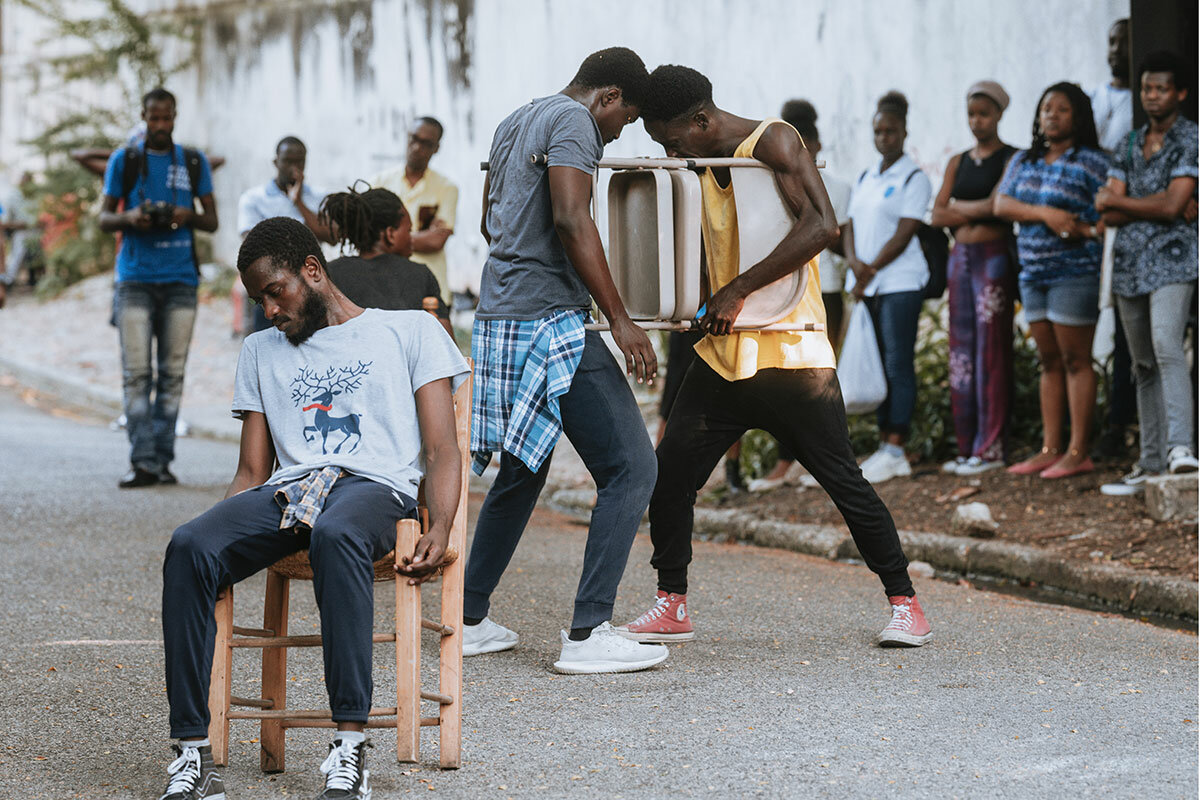
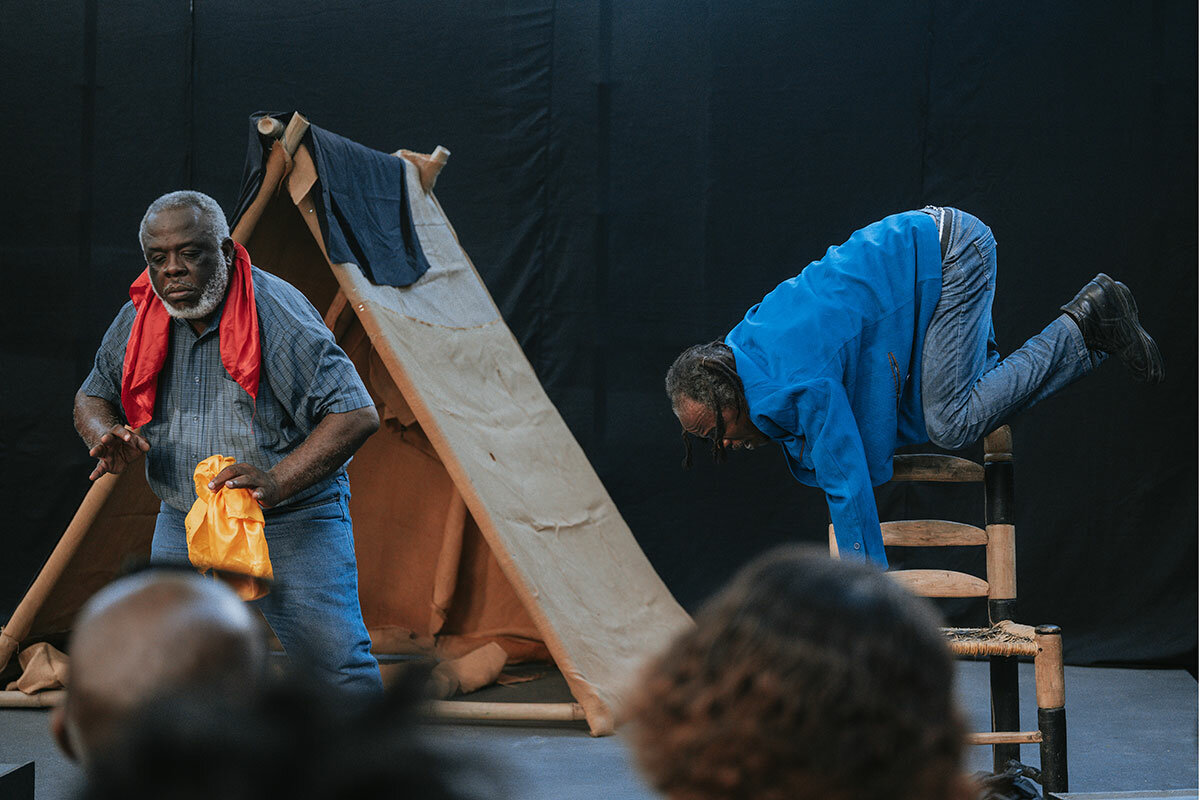
Not that the government is paying much attention to the arts in recent years, says Ms. Bien-Aimé. She’s firmly engaged in a “theater of protest,” she says, but isn’t sure her artwork frightens the government as much as her outright activism. In the summer of 2018, a massive anti-corruption movement emerged seeking accountability for the government’s squandering of an estimated $3 billion. Haitians filled the streets for months, but the assassination of President Moïse and the rapid rise in gang violence brought this key period of public dissent to a halt.
“Today, the state doesn’t even go to the theater,” she says.
But plenty of Haitians do, including other artists and students hoping to make art their lifework. Despite the enthusiasm at today’s show, violence and crime have contributed to the dwindling of live theater. To be sure, a government in chaos is part of the problem: Investment in all sectors from infrastructure to education is insufficient. That, unfortunately, translates to theaters shuttering and Haitians previously interested in pursuing the craft choosing other careers, says Mr. Guérismé.
“The question of funding has always been a thorny problem but is now exacerbated by political and social instability,” he says. His team is trying to come up with creative plans to self-finance its festival.
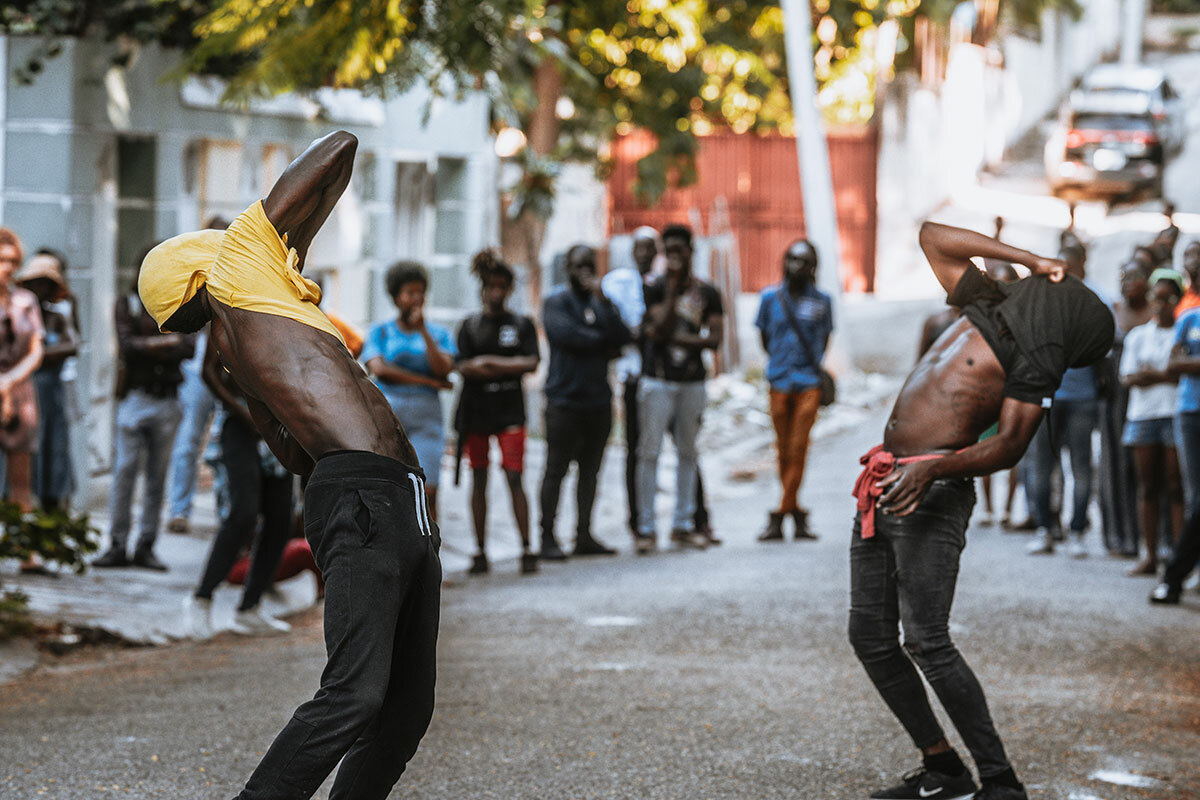
A lot depends on Haitians’ historic love for theater weathering this challenging moment.
Stephanie Jean, an NGO worker in her late 30s, rode 20 minutes on the back of a motorcycle to attend the Quatre Chemins festival. It was her first real outing since a close relative was kidnapped in August. She was in knots over whether to attend.
“Culture is one of the strongest ways we resist,” she says. “In such a politically and economically fraught context, art is how we remind ourselves and the world that we are alive,” Ms. Jean says.
“I come here to feel alive.”
This story was produced with support from the Round Earth Media program of the International Women’s Media Foundation in partnership with Woy Magazine. Melodie Cerin contributed reporting from Port-au-Prince; Nathalie Cerin translated French to English.

How Sri Lanka’s artists are keeping an iconic craft alive
It can take creativity and perseverance to save traditional crafts amid modern changes. Sri Lanka’s loyal batik artisans have both.
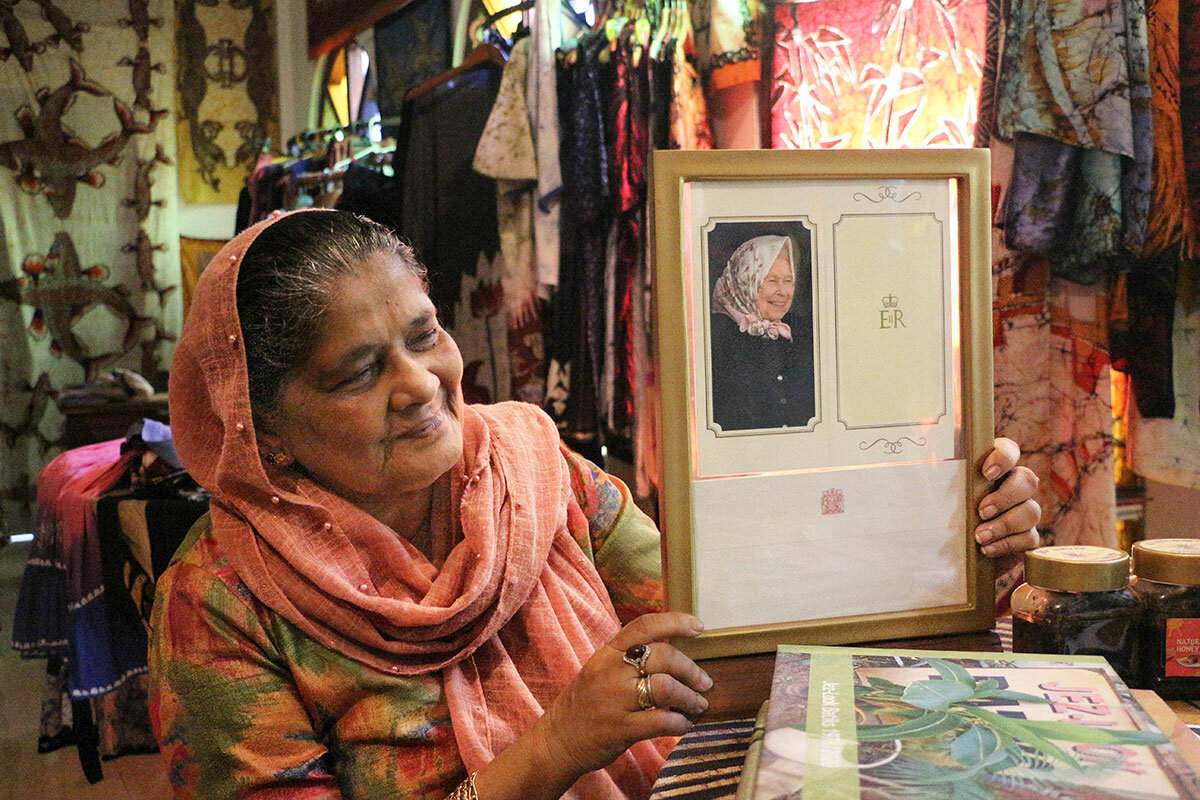
- Quick Read
- Deep Read ( 6 Min. )
-
By Zinara Rathnayake Contributor
In 1983, civil war brought Sri Lanka’s flourishing batik (wax-resist dyeing) industry to an abrupt halt, and artists and historians say it never fully recovered. Today, lingering impacts of pandemic lockdowns and record-high inflation make it difficult for cottage artisans to afford supplies, while waning interest in batik apprenticeship threatens the beleaguered art form’s future.
Yet batik continues to endure. In fact, industry veterans such as Jezima Mohammed say that decades of war and other hardships have helped prepare them for modern challenges.
“One thing is certain,” says the artist, who’s run a small batik workshop and boutique from her home in Matara, Sri Lanka, for nearly 70 years. “You have to keep going. You can’t stop your work. If you do, batik will stop.”
Although young Sri Lankans aren’t flocking to take up the laborious and often messy craft, Ms. Mohammed and other artisans are grateful to a new generation of upmarket fashion designers who seem to be taking an interest in batik. This includes Nithya Lamhewa, who shares her trendy batik streetwear with thousands of followers on social media.
“If we are to preserve the art form and champion it, we have to merge cottage batik industries with contemporary designs,” she says.
How Sri Lanka’s artists are keeping an iconic craft alive
Jezima Mohammed has run a small workshop and boutique, Jez Look Batiks, from her home in Matara, Sri Lanka, for nearly seven decades. Now in her 80s, she still works every day. When visitors stop by, the batik artist proudly shows off framed letters from Buckingham Palace and a photo of Queen Elizabeth II sporting a white satin scarf with baby pink florals – one of her designs. Meanwhile, outside, a group of artisans meticulously outline peacock motifs onto off-white fabric with boiling hot wax.
“They are my girls,” she says of the 16 women currently employed by her shop, “and we work like a family.”
It’s often said that batik came to Sri Lanka from Indonesia, where the art form is recognized by UNESCO as an important part of humanity’s intangible heritage, but late researcher Gerret Pieter Rouffaer believed it was India or Sri Lanka that introduced the resist dyeing technique to the Indonesian islands. Murky origins aside, batik flourished in Sri Lanka during the 1960s, with female artists like Ena de Silva creating massive tapestries that adorned the ceilings of Colombo’s most iconic buildings. Small businesses such as Ms. Mohammed’s shop emerged to meet the demand for the popular medium. Then, in 1983, civil war brought the industry to an abrupt halt.
It never fully recovered, say artists and historians. Today, lingering impacts of pandemic lockdowns and record-high inflation make it difficult for cottage artisans to afford supplies, while waning interest in batik apprenticeship threatens the beleaguered art form’s future. Still, batik continues to endure thanks to passionate artists across the island. In fact, industry veterans such Ms. Mohammed say that decades of war and other hardships have helped prepare them for modern challenges.
“One thing is certain,” she says. “You have to keep going. You can’t stop your work. If you do, batik will stop.”
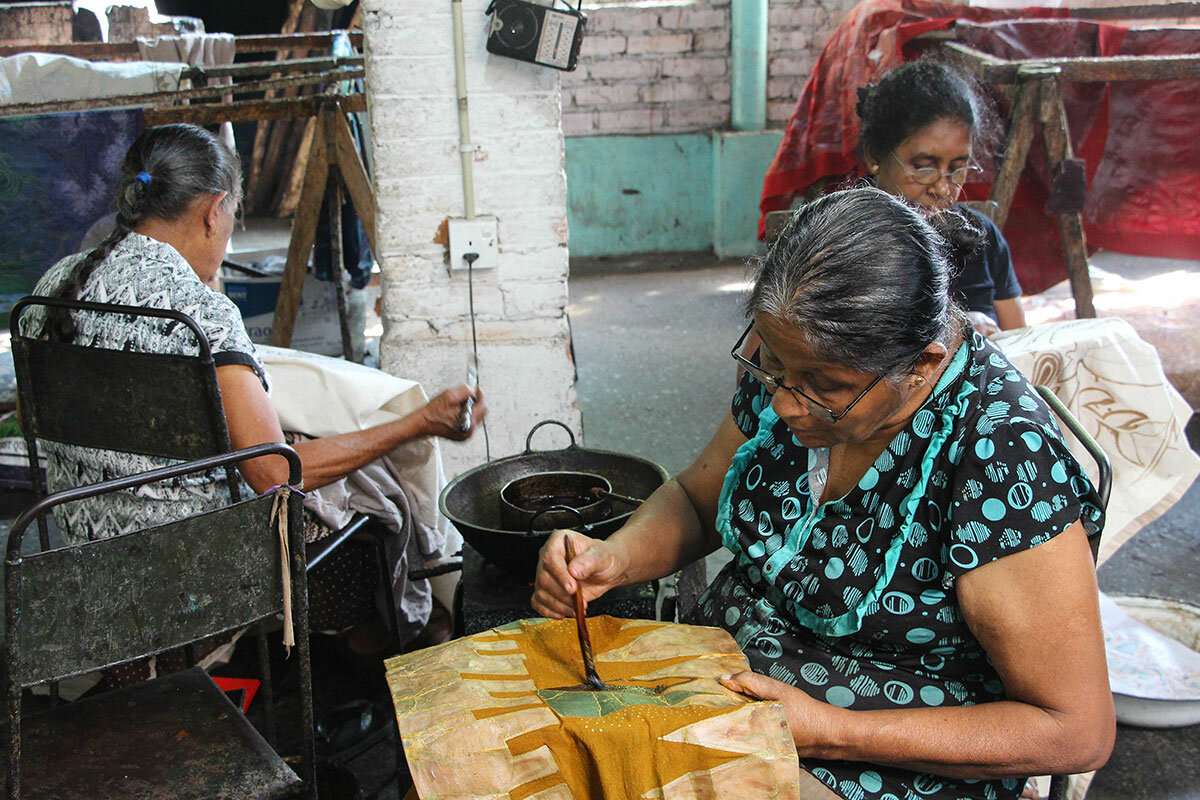
Careers defined by perseverance
Before the Sri Lankan Civil War, Ms. Mohammed’s workshop brimmed with curious outsiders wanting to learn about batik. “One traveler who came here mentioned me in an old guidebook, so everyday there was someone. Tourists loved it,” Ms. Mohammed says.
Making a batik garment starts with drawing the design on paper and planning out each color. Using a copper stylus and a mix of hot paraffin and beeswax, an artisan then outlines the pattern onto both sides of a natural, white fabric, which is then immersed in dye, starting with the lightest color. After the pigment sinks in, the artist can remove the wax with boiling water and move onto the next element of the design, repeating this process of waxing, dyeing, and boiling until the pattern is complete. The finished cloth is washed with soap and sun-dried before it’s sewn into kimonos or other garments. Ms. Mohammed also designed bedding, curtains, and staff uniforms for popular seaside hotels.
“It was a very bright, happy time,” she says. “Then the war started.”
As long standing ethnoreligious tensions erupted into violence across the island, those curious outsiders dwindled, but thanks to her now-international reputation for popular, fashionable garments, Ms. Mohammed was able to maintain a niche market for her designs. Former visitors and hotel owners continued to order new prints, and she was also invited to overseas workshops and exhibitions.
Still, times were tough, and she often found herself relying on the generosity of others.
“I met many kindhearted people who helped me a lot. When business was slow, my sons gave me small loans to pay my girls,” Ms. Mohammed says.
During lockdowns, she bore that lesson of community in mind, allowing her fellow artisans to work whenever they could and making sure they always had dry rations. “We are a team, and we have to look after each other,” Ms. Mohammed says.
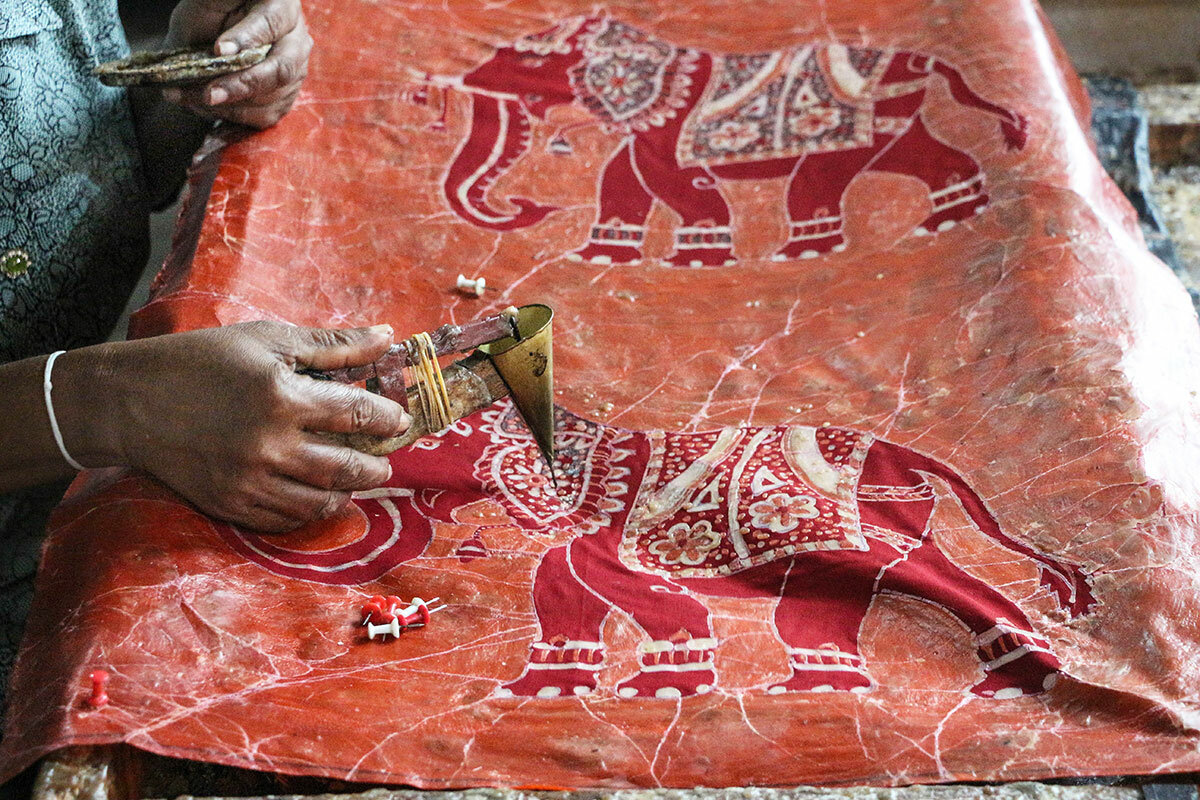
Nowadays, Sri Lanka’s cost-of-living crisis makes it difficult to afford kerosene oil, Ms. Mohammed says. She goes out daily to buy dried coconut shells as an alternative fuel for her artisans’ wax burners.
It’s a devotion shared by other batik veterans, such as Gnana Prabha Ranasinghe, who resides in the southern city Galle and is one of Sri Lanka’s few male batik designers. Like many Sri Lankan crafts, batik is widely seen as a job for women, but Mr. Ranasinghe was eager to inherit his family’s home-based workshop in the 1970s.
Like Ms. Mohammed, he persevered through war and the pandemic, and now faces challenges related to Sri Lanka’s financial mismanagement and waning interest in the art form. Mr. Ranasinghe had 40 students in the 1990s, but only eight remain today, all women.
His family and friends have often suggested he close up his workshop, but Mr. Ranasinghe carries a sense of loyalty to this craft that he learnt from his father. Batik binds together the Ranasinghe generations, he says, and “I never thought of doing anything else, not even on days there was no business.”
Industry shifts
Both Mr. Ranasinghe and Ms. Mohammed worry that their beloved batik craft may be dying, as many youth shy away from the tradition.
“Young people find it slow,” he says. “They don’t like it. They like quick computer work in a comfortable office where they can dress in ironed, polished clothes.”
It’s true that the process is laborious, time-consuming, and messy. Boiling wax dribbles all over and bright dyes stain finger tips. Many artisans spend hours on a single design, whether they’re carefully tracing small dotted textures or manipulating fabric to create free-flowing patterns. No two pieces are the same.

“People ask if I can make 20 copies of one design. I can’t. It’s original and there’ll only be one like that,” says Ms. Mohammed. But some commercial factories can get fairly close. Artists there mass-produce as many as 20 textiles a day, using a single, simplified pattern and only one or two colors of dye. Ms. Mohammed says these cheaper batiks, though often lacking in quality, are edging traditional artists out of the marketplace.
But while young artists aren’t flocking to apprentice at their workshops and batik factories, Ms. Mohammed and Mr. Ranasinghe are grateful to a new generation of upmarket fashion designers who seem to be taking an interest in their craft.
This includes Nithya Lamhewa, whose street-style batik designs were featured at last year’s Mercedes-Benz Fashion Week in Colombo. When Ms. Lamhewa started her clothing brand Nithyarn 10 years ago, there were several internationally renowned batik brands in the capital, but they didn’t appeal to Sri Lanka’s young shoppers.
“Most batik designs we had were loose-fitting, boxy silhouettes or traditional garments like saris and kurta tops. Making batik is expensive so artists didn’t want to cut out fabric to make body-fitting garments, which would waste the fabric,” says Ms. Lamhewa, who set out to add a twist to traditional batik wear.
She came up with trendy sarongs, shirt dresses, and bomber jackets with graphic batik prints inspired by endemic animals and urban life. One striped shirt dress, from her 2017 collection, featured tricolor graphic batik of tuk-tuks. She shares her rule-breaking designs with thousands of followers on social media, helping introduce Sri Lankan batik art to a new generation.
“If we are to preserve the art form and champion it, we have to merge cottage batik industries with contemporary designs,” says Ms. Lamhewa.

Trumpet star doesn’t put music – or people – in boxes
Grammy nominee Ibrahim Maalouf sees music as a way to show people how they are more alike than different – and to celebrate those similarities.

- Quick Read
- Deep Read ( 4 Min. )
Ibrahim Maalouf, who fills arenas in France and attracts sizable audiences worldwide, doesn’t make music that sounds like that of a typical trumpeter.
His custom-made instrument has a fourth valve, rather than the traditional three, so he can play quarter tones – the notes between notes. Mr. Maalouf, who was born in Lebanon and raised in France, credits his dad for inventing the microtonal trumpet.
“For me, quarter tones are in all music,” says Mr. Maalouf in a Zoom interview. “The reason why my father created this trumpet was to play the Arabic quarter tones, the Arabic scales. But a good musician could use it for any kind of music.”
On Feb. 5, Mr. Maalouf will be attending the Grammy Awards in Los Angeles. He and Beninese American songwriter Angélique Kidjo are best global music album nominees for their collaboration, “Queen of Sheba.” Mr. Maalouf says he is guided by a musical philosophy: If his compositions help people see beyond musical boxes, maybe they’ll see past other divisive labels, too.
“If you are able to discover what is behind the external aspect, that means you understand philosophically what this music is about,” he says. “That means we belong to the same world. And we can think about a better future, all together.”
Trumpet star doesn’t put music – or people – in boxes
It’s almost unheard of for a modern-day trumpet player to break out from the niche world of jazz clubs. But Ibrahim Maalouf, who fills arenas in France and attracts sizable audiences worldwide, doesn’t make music that sounds like that of a typical trumpeter.
His custom-made instrument has a fourth valve, rather than the traditional three, so he can play quarter tones – the notes between notes. Mr. Maalouf, who was born in Lebanon and raised in France, credits his dad for inventing the microtonal trumpet.
“For me, quarter tones are in all music, from blues to Negro spirituals to Indian music to folkloric Gypsy music,” says Mr. Maalouf in a Zoom interview. “The reason why my father created this trumpet was to play the Arabic quarter tones, the Arabic scales. But a good musician could use it for any kind of music.”
On Feb. 5, Mr. Maalouf will be attending the Grammy Awards in Los Angeles. He and Beninese American songwriter Angélique Kidjo are best global music album nominees for their collaboration, “Queen of Sheba.” Mr. Maalouf’s other 2022 release, the hip-hop influenced “Capacity To Love,” features guests such as De La Soul and rapper D Smoke. The two albums showcase his stylistic breadth. He is guided by a musical philosophy: If his compositions help people see beyond musical boxes, maybe they’ll see past other divisive labels, too.
“He’s really open-minded,” says Norwegian trumpet player Nils Petter Molvær, a pioneer of fusing jazz and electronic music, in a Zoom interview. “He doesn’t care very much about genres.”
Mr. Maalouf grew up listening to the Arabic and classical music of his father’s trumpet and his mother’s piano. One day, when he was a boy, his mother came home with a vinyl single of Michael Jackson’s “Smooth Criminal” that she’d won in a supermarket competition.
“I played it, and suddenly my body started to move and I started to dance,” he says. “I had never heard something like this before.”
Smitten by pop music, he took up the synthesizer, once waking his mother at 3 a.m. with his playing. But his main focus was studying trumpet. It was a way to bond with his strict father. Mr. Maalouf won classical music competitions and studied at a well-known Paris conservatory. “All this was because my father wanted me to be the best trumpeter, not because I wanted it,” he says. “I said, ‘That’s over. I’m done. Bye-bye. My trumpet is out of my life.’”

He briefly dallied with the idea of becoming an architect. But a burgeoning desire to score movie soundtracks inspired Mr. Maalouf to retrieve the instrument from its box. He was filled with new gratitude that his parents had always encouraged him to compose music. The musician resolved that, this time, he wouldn’t try to impress others with virtuosity. Even so, it took him years to develop a more soulful way of playing. Onstage, his happy eyes now gleam as much as his trumpet.
“He has enormous dynamics in his playing, from the very, very, very soft to pretty hardcore,” says Mr. Molvær, who has performed with Mr. Maalouf. “He has his very own voice. You can say, ‘Ah, that’s Ibrahim.’ Sometimes his trumpet sounds like a different instrument, like a flute or something from the Middle East.”
In 2015, Mr. Maalouf utilized that ability on an album of songs by Oum Kalthoum, Egypt’s iconic singer from the early 20th century. When he performed “Kalthoum” at Lincoln Center in New York, it was ostensibly a jazz concert. But after an Egyptian in the audience started singing along in his first language, Mr. Maalouf explained to attendees that what they’d been listening to was a traditional Arabic melody.
“There were people [saying], ‘Wait, what?’” he recalls. “What I like is when you prove to all the people who are listening that we actually all share exactly the same melodies. We just dress them differently.”
Soon after, Mr. Maalouf teamed up with Ms. Kidjo for a conceptual suite about King Solomon meeting the Queen of Sheba. It was challenging to write music for words in the Yoruba language. Once the trumpet player latched on to the rhythms in the singer’s phrasing, it opened a portal between African and Middle Eastern modalities.
“It sounds like a real mix, not a superimposition of things,” he says.
The artist’s 15th album, “Capacity To Love,” opens with Charlie Chaplin’s monologue from “The Great Dictator,” a film that mocked Adolf Hitler, in which the character calls for unity and a recognition of universal brotherhood. “When I see what’s happening everywhere in Europe, the far right, extreme right getting more popularity, it makes me wonder if people really learn from past mistakes,” says Mr. Maalouf. “Suddenly, I had this speech by Charlie Chaplin in my head.”
Mr. Maalouf says that people too often judge others by their skin color, the way they’re dressed, or their religious beliefs. But he believes there’s a lesson in the way that “Capacity To Love” finds common ground between hip-hop, New Orleans R&B, Romani music, and 1970s jazz fusion.
“If you are able to discover what is behind the external aspect, that means you understand philosophically what this music is about,” he says. “That means we belong to the same world. And we can think about a better future, all together.”
Other headline stories we’re watching
(Get live updates throughout the day.)The Monitor's View
Recharging a river with a flow of trust
- Quick Read
- Deep Read ( 2 Min. )
-
By the Monitor's Editorial Board
For the second time in six months, the seven states that make up the Colorado River Basin failed yesterday to meet a federal deadline to reach an agreement on how to cut their cumulative consumption of the river’s water by as much as 40%. That austerity is necessary to prevent the system’s collapse after 23 years of drought.
What happens next is uncertain. The necessity for stark and balanced sacrifices by the basin states underscores the challenges of adapting to severe weather disruptions. Yet even before an agreement can be reached, mental dams need to be broken. The current system is built on division and exclusion. Rival water users would need to redefine water security on a new basis, one that starts with trust and leads to fairness.
The Colorado River crisis is forcing a reevaluation of the human currency of shared security across the arid West. The opportunity, writes Bruce Yandle, a former Federal Trade Commission executive director, is to “make scarcity a prelude to plenty.”
Recharging a river with a flow of trust

For the second time in six months, the seven states that make up the Colorado River Basin failed yesterday to meet a federal deadline to reach an agreement on how to cut their cumulative consumption of the river’s water by as much as 40%. That austerity is necessary to prevent the system’s collapse after 23 years of drought – the most severe and prolonged dry stretch in more than a millennium.
What happens next is uncertain. Forty million people depend on the river for water and hydropower. Washington may impose rationing on the states for the first time in history, a move that would almost certainly trigger lawsuits. The U.S. Department of the Interior has already imposed reduced releases from lakes Powell and Mead, the basin’s two main reservoirs. Both are in danger of reaching levels too low to allow water to flow downstream.
The necessity for stark and balanced sacrifices by the basin states underscores the challenges of adapting to severe weather disruptions under laws drafted long before such a historic drought was foreseen. Yet even before an agreement can be reached, mental dams need to be broken. The current system is built on division and exclusion. Rival water users would need to redefine water security on a new basis, one that starts with trust and leads to fairness.
“What used to happen is that the powers that be would get together and figure out what to do, and then tell everyone else what the plan was,” Stephen Roe Lewis, governor of the Gila River Indian Community in Arizona, told The New Yorker this week. “And what’s changed is that you just can’t do that anymore. Those days are over.”
The Colorado River Basin is governed by a century-old compact that allocated the full volume of water flowing through the river and its tributaries to the seven states. That scheme deliberately sidelined 30 tribal nations whose rights to those waters predated the compact. A 1963 Supreme Court decision affirmed the tribal water rights, but the nations have been battling ever since for control of their allocations.
That is now changing. For the first time, the states are starting to work seriously with the tribes. These nations hold rights to 20% of the basin’s water. Honoring those rights – and the dignity they represent – is a first step toward building new partnerships. In Arizona, for example, the Jicarilla Apache Nation is set to release 20,000 acre-feet of water from the San Juan River, a major southern tributary to the Colorado River, in a deal brokered with environmentalists and Arizona state officials. Deals like that show the uniting effect of environmental extremes.
The Colorado River crisis is forcing a reevaluation of the human currency of shared security across the arid West. The opportunity, as Bruce Yandle, a former Federal Trade Commission executive director, wrote in The Hill recently, is to “make scarcity a prelude to plenty.”

A Christian Science Perspective
Each weekday, the Monitor includes one clearly labeled religious article offering spiritual insight on contemporary issues, including the news. The publication – in its various forms – is produced for anyone who cares about the progress of the human endeavor around the world and seeks news reported with compassion, intelligence, and an essentially constructive lens. For many, that caring has religious roots. For many, it does not. The Monitor has always embraced both audiences. The Monitor is owned by a church – The First Church of Christ, Scientist, in Boston – whose founder was concerned with both the state of the world and the quality of available news.
Trusting our wishes to God
- Quick Read
- Read or Listen ( 3 Min. )
-
By Mark Swinney
Yielding to God’s will, rather than willfulness, brings direction and fulfillment, as a man learned when applying for a new job.
Trusting our wishes to God
What would it mean if every single wish that anyone ever made came true? While we’d certainly be seeing a lot of wonderful happenings, we’d also be dealing with the effects of destructive and ill-conceived desires. How chaotic might the world become?
But there’s a way to consistently improve and elevate our desires: honestly making space in our thought for God, rather than letting willfulness take over. Monitor founder Mary Baker Eddy explains right at the beginning of her book “Science and Health with Key to the Scriptures,” “Desire is prayer; and no loss can occur from trusting God with our desires, that they may be moulded and exalted before they take form in words and in deeds” (p. 1).
Christian Science explains that God created every one of us spiritually, and therefore our real purpose isn’t about manipulating physicality, it’s about expressing God’s loving, capable, and utterly good nature. God’s will for us is always to shine brightly with His reflected light! Choosing to embrace God’s will is a form of prayer, as Jesus demonstrated when he said, “Not my will, but thine, be done” (Luke 22:42).
I discovered the joy of embracing and trusting God’s will during a job search. I had learned about a job I thought was perfect for me. I began wanting it so badly that I could taste it! Not long after applying, I found another job opening that was mildly interesting to me and paid much less. I applied for it too.
My passionate wish for the first job was blinding. As I waited for interviews, I began feeling uncomfortable with how willful I was being. I realized that it was time to change my whole approach. Instead of indulging in my own personal will, I felt called to yield everything to God’s will.
So my prayer changed from “God, please give me the job I wish for because I know it will make me happy,” to “God, what matters most is that wherever I am, I am useful to You. I only want Your will for me.” As God’s children, we are always within the infinitely good care of God, and that means that we can trust God to express Himself in us without reserve. Wherever we may find ourselves, there are opportunities to express God’s spiritual, good qualities.
When we subordinate our personal wishes to God’s will, it clears the air for us mentally and brings to bear in our thought and experience the power and action of God.
That’s what I experienced with how smoothly things progressed. I received offers for both jobs. But now, whenever I considered the second job, I felt the peace and love of God. I knew that this was God leading me. Without looking back, I took the second job, and it ended up preparing me for even more gratifying and useful work than I ever could have imagined. What an important lesson.
Yes, it would be a curious thing if every single person’s wishes, good or bad, came true. So in our prayers, we can give our desires to God so that they may be brought into line with His will and, thereby, truly bless.
In this very moment, God’s infinitely good will is available to each one of us, without exception. It’s natural for us to open up to our Father’s peaceful, loving leadings. And when we do, we’ll discover our path is always to thrive as God’s entirely spiritual expression, and this gift is beyond anything for which we could dream.

A message of love
An earthly flyby

A look ahead
Thank you for joining us today. Please come back tomorrow when we look at a program that pairs incarcerated people with outside writers to help them find their voice and prepare for rejoining society.



